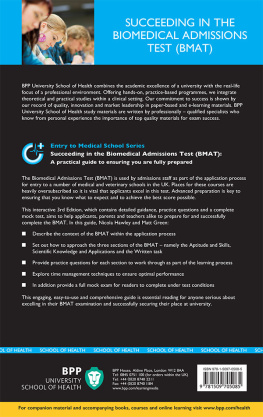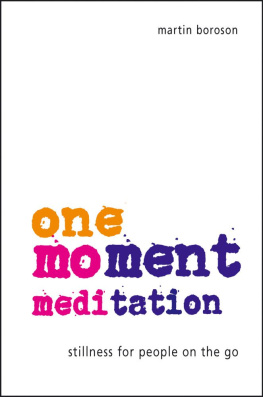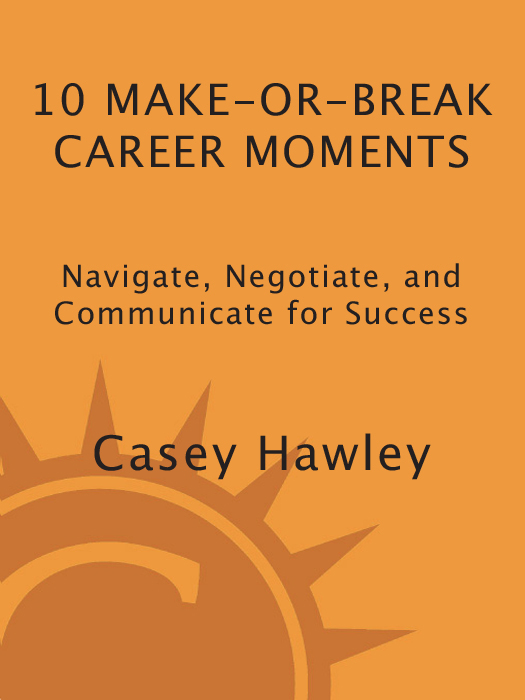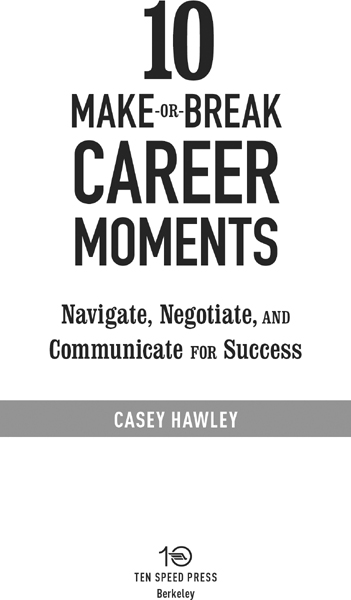Dedication
To my prayer partners who have implored God that I would not always say the first thing that comes to my mind and who have been successful most of the time, at least when I would listen. Special thanks to Frances Pastore, Mary Thomas, Belinda Stone, Ann Kieffer, Caroline Long, Joyce Johnson, Angela Mitchell, Teresa Gernatt, Carolyn Caswell, Sandra Robinson, Chris Reynolds, Cathy Russo, Joan Holsenbeck, Sharon Powell, Ginny Scruggs, and Debbie Howell. They have worn out their knees in prayer for me as I have learned the lessons I pass along in this book. Thank you.
CONTENTS
CHAPTER 1
CHAPTER 2
CHAPTER 3
CHAPTER 4
CHAPTER 5
CHAPTER 6
CHAPTER 7
CHAPTER 8
CHAPTER 9
CHAPTER 10
CONCLUSION
Game plan for real life communication: Six models for your future success
INTRODUCTION
T here is a secret handshake in business. There are codes and passwords that allow some people to pass on to higher levels. Not knowing these door openers can hold you, as a professional, back from the career you deserve, no matter how smart you are.
The real challenge is that the secrets you need to know are not called passwords or handshakes; they are far more subtle than that. The secrets that can advance your career are the unwritten rules, regulations, and nuances of what to do, what to say, and how to approach situations that pop up along your career path. What do you say when you unexpectedly find yourself side by side with an executive who can offer you a job or promote you in your company? How do you meet a new committee or team and communicate with members in a way that makes them embrace your ideas from the very start? What is the best way to handle that job interview? How do you accept awards, honors, and promotions in a way that wins the affirmation of your peers and not their jealousy? What do you say when you suddenly find yourself in a conflict with a coworker? And perhaps most important, how do you ask for a raise?
10 Make-or-Break Career Moments defines these door-opening moments and shows you how to navigate them triumphantly. In this book, you will find strategies for fluidly and confidently responding to these critical moments that can make your path to success faster and easier. Not following these strategies can mean taking unnecessary detours along the wayand delaying your success. You could miss out on that all-important job opportunity or fail to be asked to be part of an influential team or focus group in your company. You might miss the opportunity to impress an executive who could offer you a role in a new project or offer you a great job recommendation. You might even appear less savvy, professional, and mature than you really areand you dont want to misrepresent yourself that way. Communicating effectively in these crossroads moments will ensure that you leave a positive and powerful impression on all you encounter.
Nothing alters your path to success like the right communication. The right word said at the right time can propel your career forward; conversely, careless words blurted out in one of those ten critical moments can damage an influential persons view of you forever.
The one common thread that will run through your entire career is that your communication will always be the chief tool with which you will reach your goals: better jobs, great teamwork with colleagues, and effectiveness with the people you manage. You will be continually honing your communication at every level, becoming more polished and professional in choosing your words. This book is a fast-track tool to prepare you right now for the most important moments in your career.
The ten particular moments focused on in this book were chosen based on consultations and interviews with hundreds of professionals in all industries, small businesses, nonprofits, education, government, and even places of worship. In every type of employment, communication was valued as an indicator of how successful an employee would be. These ten moments are universal and highly important to the employees success, whether you measure success by salary, position, career satisfaction, or your impact on other people.
You will probably experience all ten moments: certainly all that relate to the job search process, conflicts with others, awards and recognition, as well as being fired or resigning. These moments are career-changersaltering your circumstances and probably your income for better or worse, depending on how you respond to what is going on in that moment. Every situation is different, but this book allows you to discover what other people have found to be successful in similar moments. Based on my experience as a consultant for more than twenty years, I have distilled each great idea into practical suggestions. Finally, this book is a great primer for those who can only think of the right thing to say after the fact, when opportunities have passed them by, and they are left with regrets for what might have been. With the help of these proven strategies, you can be the person who says the right thing at the right time.
THE FIRST MOMENT YOU MEET AN EXECUTIVE OR OTHER KEY BUSINESS CONTACT
W ho in a company receives the least positive feedback of anyone in the organization? The janitor? No. The CEO. The higher up you go in an organization, the fewer attaboys and acknowledgments you receive on a daily basis. Although managers and supervisors are generally conscientious about giving hourly workers and lower-level professionals positive feedback for a job well done, no one feels it is necessary to do that for the executives. Those who get this kind of feedback generally respond very well to it; why, then, dont we offer our higher-ups the same strokes?
Executives listen to information all day and deal with problems. Positive communication is in short supply some days. When executives are at social functions or even company receptions, they, like anyone else, would welcome hearing about whats going right, interesting observations, and breaking news from the community and their industry. When you realize this, youve got the basis for a model of what to talk about when you suddenly find yourself standing beside an executive at a company function or at an industry conference.
There you are, standing by the coffee urn or the cash bar, and suddenly you realize that the person standing next to you is a vice president from your company. Should you take the cowards way out? Tell yourself that he does not want to talk to someone of your lowly status and quietly edge away? Not if you are trying to advance your career. For all you know, the executive would welcome someone new to talk to and may be trying to avoid the same old crowd he hears from all the time. You could be just the person who will turn a tedious night into a refreshing experience for him.
Sometimes, when professionals are put on the spot to converse with an executive, they become desperate to say somethinganything. Big mistake. An inexperienced conversationalist may say something that comes out as critical or shallow. Your response to the opportunity to make a great impression becomes pretty unimpressive.

















